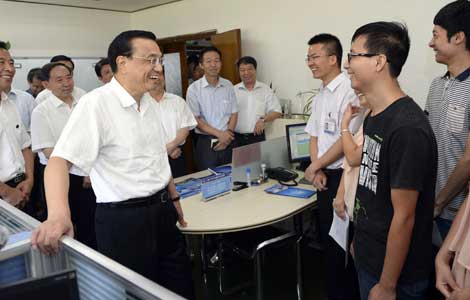Cross-border workers boost China-ASEAN ties
Updated: 2013-08-19 13:33
(Xinhua)
|
||||||||
NANNING -- Every morning, more than 7,000 Vietnamese walk across the border and start work in a Chinese town.
Nguyen Thi Dung, an interpreter, is one of them. She lives in the Vietnamese city of Mong Cai but works in Dongxing city in China's Guangxi Zhuang autonomous region.
The 27-year-old woman has a number of clients in Dongxing. With the help of people like her, Vietnam sells seafood to China, while China exports clothes and domestic appliances to Southeast Asia.
Dung earns at least 200 yuan (about $33) every day, nearly five times the amount of the average Vietnamese do.
"It's been my dream for a long time to speak Chinese well and work in China," she said.
The free trade area built by China and the Association of Southeast Asian Nations (ASEAN) provides opportunities for more people to make decent salaries like Dung.
The preferential trade policies and zero tariffs for thousands of commodities have resulted in an increasing number of Chinese and ASEAN citizens working across borders.
Vietnamese businesswoman Lu Thi Mot started to seek opportunities in Dongxing a decade ago.
After years of hard work, Mot now runs a Vietnamese specialty store at a trade center in Dongxing.
Every morning, Mot walks to her store in China, and in the afternoon, she returns to home in Vietnam. Her business is booming.
Chinese living in the border area can buy up to 8,000 yuan of Vietnamese goods every day without paying tariffs. This has resulted in mushrooming border transactions.
"There are about 90 Vietnamese stores at the trade center, and transactions exceed 10 million yuan each day," said Yao Qiwei, deputy director of Dongxing's border trade management bureau.
To facilitate the transactions, the People's Bank of China in July approved a pilot project of individual cross-border renminbi, or China's currency, settlement in Dongxing. The cross-border workers only need to provide receipts to conduct transnational settlements for amounts less than 800,000 yuan.
The regulation will allow the China-Vietnam border trade to grow even more quickly, Yao said.
The trade center is only one example.
In Vientiane, capital of Laos, cars with Chinese license plates are everywhere. Many Chinese go there to work.
The Chinese can easily drive to Laos through ports in Yunnan province, with simple procedures. Many Chinese work in factories there on weekdays and return to China on weekends.
In Yunnan's Ruili, China's border city with Myanmar, the number of cross-border workers stands at around 30,000, accounting for one third of the city's population.
Ruili is the biggest destination for Myanmar's labor exports. Most of such Myanmar citizens work in jewelry, logistics, tourism and interpretation.
Huang Zhiyong, deputy dean of the Guangxi Academy of Social Sciences, said the cross-border workers are the epitome of China-ASEAN cultural exchange.

 Ride to fly on the top of mountains
Ride to fly on the top of mountains
 Nadal beats Isner to win first Cincinnati crown
Nadal beats Isner to win first Cincinnati crown
 Wild Africa: The new attraction to Chinese tourists
Wild Africa: The new attraction to Chinese tourists
 Azarenka beat Williams for Cincinnati title
Azarenka beat Williams for Cincinnati title
 500th eruption of Sakurajima Volcano in 2013
500th eruption of Sakurajima Volcano in 2013
 A cocktail that's a treat for the eyes
A cocktail that's a treat for the eyes
 Private sector to care for the elderly
Private sector to care for the elderly
 Be innovative, Li tells graduates
Be innovative, Li tells graduates
Most Viewed
Editor's Picks

|

|

|

|

|

|
Today's Top News
Iran signals willingness to resume nuclear talks
Baby formula sales to be shifted to pharmacies
CIA document release acknowledges Area 51
36 killed in Egypt's prison truck escape attempt
Be innovative, Premier Li tells graduates
Onus on US to improve military ties
Trustee council may be answer for reforming
40 killed as floods ravage NE China
US Weekly

|

|







